
Content Ratings and Other Third-Party Value-Added Information
Defining an Enabling Platform
Martin Röscheisen
[email protected]
Terry Winograd
[email protected]
Andreas Paepcke
[email protected]
Stanford Integrated Digital Library Project
Computer Science Department
Stanford University
Stanford, CA 94305, U.S.A.
D-Lib Magazine, August 1995
-
- Scenario: Imagine you want to know what your colleagues
in the interest group
DLissues have found worth seeing
lately. In your browser, you select "Tour annotation set
DLissues", with the filter set to "annotations
newly created since yesterday". You get a report containing
pointers to annotated locations in various documents; you inspect
some of these links with a comment previewer. Sara evidently appreciated
a paper on security in the proceedings of a conference last year--she
gave it the highest ranking on her personal scale. You click on
the link and jump to the annotated section in the paper. You scan
it up and down and wonder whether the security research group
you know at another university has any opinion on this paper.
You turn on their annotation set SecurityPapers,
which you can access free of charge since your school has a site
licensing agreement. You see that they have made a "trailmarker
annotation" to the top of the paper. You inspect the annotation
icon with the previewer: it says that the paper you are viewing
is really subsumed now by the one at a more recent conference
which the trail marker points to. With another click you jump
to this more recent paper, which turns out to be written even
more clearly. You go back to reply to Sara's original comment
and include a pointer to the SecurityPapers set.
As part of the Stanford Integrated Digital Library Project,
we have designed and prototyped an architecture that supports
such scenarios by defining an enabling platform for various kinds
of third-party value-added information on top of the existing
World-Wide Web infrastructure.
A research prototype implementation ("ComMentor")
was completed in late 1994 and has been refined and evaluated
since then. As a spin-off from our digital library project, the
protocols have been published to the World-Wide Web developers
community; the code has been made available to other developers
to enable possibilities for wider adoption and for the development
of related standards.
A rich variety of usages can be readily realized using a generalized
mechanism for shared "annotations," which underlies
our architecture. These usages include shared comments, collaborative
filtering, seals of approval, guided tours, usage indicators,
co-presence, and value-added trails.
Third-Party Value-Added Information and the Need for an Enabling
Platform
Figure 1 shows a simplified depiction of what browsing on today's
World-Wide Web is like: the user's view is limited at any time
by whatever information and pointers a content provider makes
available.

Figure 1
This contrasts to the way in which many kinds of information are
used to add value. For example, Consumer Reports-type evaluations
about product information, or a professor's comments about a conference
paper are generally authored, published, and controlled independently
of the underlying content. When users look at the product information,
they might want to have a pointer to the corresponding Consumer
Reports section--even if a product manufacturer does not necessarily
appreciate a review. Note also that while there might be access
control and charging for the product information, the value-added
super-structures will in general be access controlled and charged
independently.
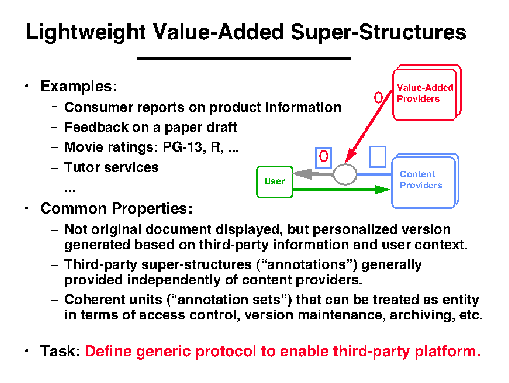
Figure 2
Usages of third-party annotations are not limited to personal
annotations. When properly supported by the underlying infrastructure,
they also help in the context of collaborative work groups. Annotations
can indicate which participants of a group have seen a document;
they can afford structured discussion about paper drafts and collaborative
filtering.
Annotations that include hyperlinks can be used to construct guided
tours through a document space or trails in the form envisioned
by Vannevar Bush (see also [VB]). Since annotations
conceptually reside on pages, such "landmarks" naturally
implement a generalized notion of a "hotlist", which
is shared among arbitrary groups of people, and where visibility/access
is controlled on a per-section level. Annotations can also be
used by participants to indicate their "presence" at a document.
But one use of annotations has most recently risen to particular
prominence: seals of approval (SOAPs) and their use for content
ratings.
Content ratings have been debated intensively as part of the excitement
around the Communications Decency Act in the US Senate: Parents
might want to have certain Web pages rated. Browsers might then
refuse to render documents with particular ratings. Without further
analysis, such a capability could easily be provided, and several
solutions have been proposed. For example, [TimBL]
suggests that content providers include a "self-rating field"
in their documents. The "KidCode" proposal [Borenstein]
suggests encoding rating information in document URLs. These approaches
exhibit an important weakness: They ignore two important aspects
of content rating. Ratings are given from different points of
view, and for different purposes. Thus, documents that are considered
rated "R" by some parents, might not be objectionable
to others in a different country, or even in a different part
of town. Rather, parents should be able to select rating "sets"
of their choice prepared by organizations they trust to reflect
their values.
Content rating annotations are intrinsically relative to perspective,
value system, and intended use, and flexibility becomes even more
significant when considering rating individual documents from
multiple perspectives. The Playboy(TM) Web site might be rated
"guidance advised" by a committee of parents; it might
also be rated "picture quality good" by an organization
of professional photographers, or it might be rated "slow
site" by someone who rates sites according to their latency.
These properties of third-party value-added information make it
in general undesirable, if not infeasible, to have content providers
also provide the associated third-party information, which was
prepared differently in terms of authority, intention, access
control, burden of resource usage etc. Once we acknowledge the
specific nature of third-party value-added information, it becomes
clear that its independence needs to be reflected architecturally.
The ComMentor architecture enables independent third parties to
provide value-added information ("annotations"), and
it provides a generic mechanism for users to choose which kind
of such information ("annotation sets") will be "superimposed"
when viewing documents.
Outline of the Architecture
The basic architecture is shown in Figure 3. Users interact with
a "context-control application" in which they select
the third-party source and the type of information ("annotation
set") they want to see at a given point in time. For example,
while browsing for information on personal computers, someone
might choose to turn on the PCratings annotation
set of a well-known computer designer to get hints about some
of the salient issues of the various PCs.

Figure 3
Based on the user context, a document synthesis module retrieves
the currently requested document (from any document server on
the web, using the standard protocol)--and also retrieves all
of the relevant meta-information that might be present about this
particular document at any meta-information server that is providing
one of the annotation sets currently being displayed by the user.
Note that this holds conceptually; in practice, it is possible
to eliminate a large number of such requests by caching a list
of annotated sites. (See [TR]
for a more detailed discussion.) The returned meta-information
will then be used by the synthesis module to generate a document
which contains the relevant value-added information. The result
will be displayed to the user.
Conceptually, we have the following four layers: People with a
certain identity representation are members of certain access
control groups. Annotations are organized into what we call "annotation
sets". These are usually like topics, or like threads in
newsgroup readers, and they organize annotations in much the same
way as directories do with files.

Figure 4
For example, Terry and Chris are members of the DL Group.
As such they may add or modify annotations in the CSD set.
But they can only view the annotations in the Demo set.
Examples from the ComMentor Prototype
In this section, we will give some examples of how annotations
are used in the ComMentor prototype. For a more complete description,
see the Technical Report.
Annotations are of different types. There are "comment annotations"
for basic commenting, "tour annotations" for guided
tours, "SOAP annotations" for content ratings, and others.
All annotations contain information such as who authored them
when, and which annotation set they belong to. Each of the annotation
types defines a number of additional attributes. For example,
a tour annotation would have in addition the location to which
it points. The type also determines the default client behavior
once an annotation is selected. For example, clicking on a "tour
annotation" will in general lead to the next tour stop, while
clicking on a "comment annotation" will show the full
text view of the annotation.
The corresponding meta-information description for an annotation
is automatically generated and stored on the annotation server
whenever a user uses the "Create Annotation" dialogue
box of the browser (Figure 5).
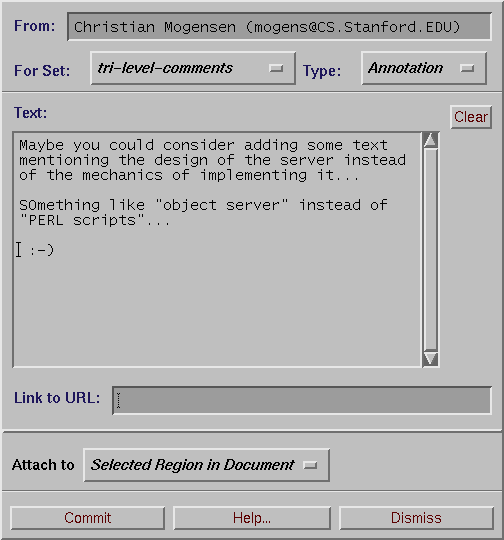
Figure 5
Comment Annotations
Comment annotations are indicated in the interface as tiny icons
containing the faces of the author, or (in an alternate viewing
mode) an icon of the group to which it was written. Such images
are active anchors in that users can click on them to view the
comment. We have implemented a previewing mechanism, a yellow
PostIt(TM) type window, which pops up when clicking the middle
mouse button on an annotation, and which allows a light-weight
quick reading style that is more convenient for short comments
than the full retrieval of the comment as a web page.
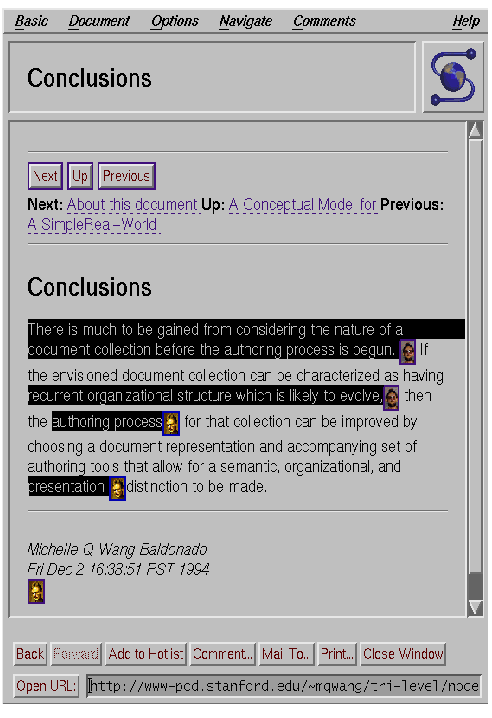
Figure 6
The picture above shows some comments inlined into the base text
(with the highlighted regions shown). Figure 7 shows the previewer
being used to inspect an annotation (yellow PostIt viewer).
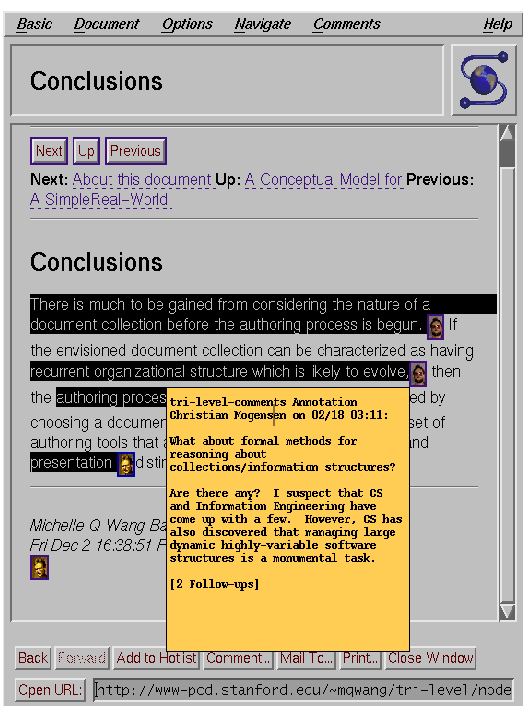
Figure 7
One typical problem with annotations is that they "get lost":
The only way to see them is to know the page to which they are
attached. We avoid this problem with a general query capability
on our annotation servers, which lets user query annotations according
to various criteria. For example, they can ask for all annotations
which have been created since yesterday and were written by Andreas.
Such a query result shows up in the browser as a "hotlist"-like
page where each list item is a link to an annotation.
Seals of Approval (SOAPs) for Content Rating
Content rating is done by writing annotations to pages with respect
to specially designated sets whose access control properties are
set such that they are readable by whoever the audience is (often:
everyone, that is, public), and writable only by whoever belongs
to the issuing authority. For example, the French Academy might
want to reward especially elegant use of the French language.
To that end, it could create a set LeVraiFrancais
whose access permissions are set such that only academy fellows
have write access, but everyone in the public has read access.
Anyone on the Web could then turn on this set, and gain insight
as to the extent to which a particular document is written in
proper French.
There are two basic usages of rating sets: First, using the ability
to query the annotation server for a list of pointers to annotations,
we help people find what they are looking for. In the following
figure, we have queried the PCD_SOAP for a list of
ratings, among which we can preview the more detailed ratings
and then jump to a location of our choice.
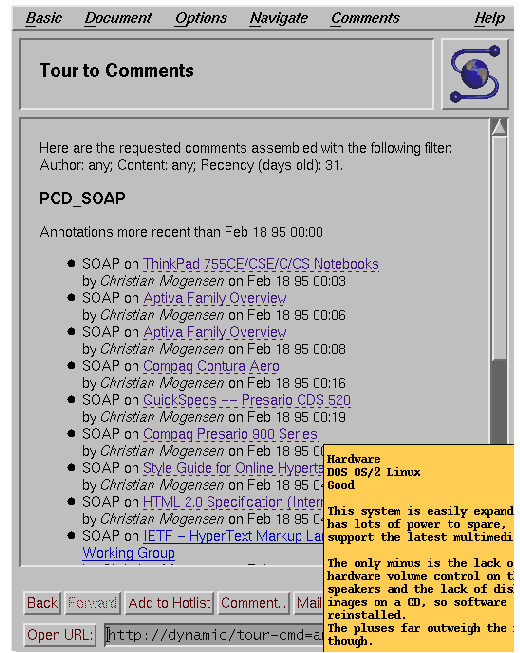
Figure 8
The other main usage of SOAPs is to give people information about
something once they happen to run into it. This includes the typical
parental guide application (see figure below). Note that here
we pop up a notification window; a more useful action might be
in this context not to show the page at all.
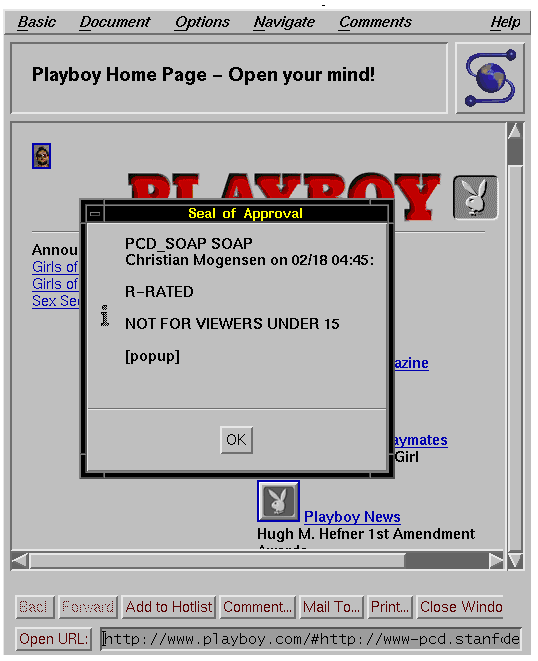
Figure 9
We have implemented a basic set of visibility controls for Seals
of Approval, which use annotation information to perform extra
actions on the client side. These include not showing the underlying
document at all (which would be useful in the parental guide case),
or popping up a window with a warning message.
Note that the general SOAP structure accommodates any rating scheme:
the rating system itself is described as part of the meta-information
describing a rating set. For example, a simple annotation set
might be created to contain rating values "good" or
"bad", while a more sophisticated set might contain
values "rated R for nudity", "rated R and recommended
for minimum age 15", etc.
Guided Tours
All sorts of guided tours and independently threaded super-structures
can be readily realized within the generic architecture outlined
above.
For example, we have set up a number of tour sets which give different
tours through a single document collection, namely the WebLouvre museum.
There is one tour about the Baroque, one tour for the French painters,
and a tour for impressionists. As an example, a page describing
the work of Claude Lorrain is both on the Baroque tour and on
the FrenchPainter tour. But when a user has selected
a certain tour (by activating the corresponding annotation set),
each page contains only the relevant navigation signs: If we look
at Lorrain in the context of the Baroque tour, then the sign will
lead us ahead on this tour; if we are on the FrenchPainter
tour, it will point to the next tour stop on that tour. We can
control access and/or charges for tours independently, and there
can be any number of such tours--no-one will be confused by a
multiplicity of signs on a given page, and the guidance information
scales with the number of tours.
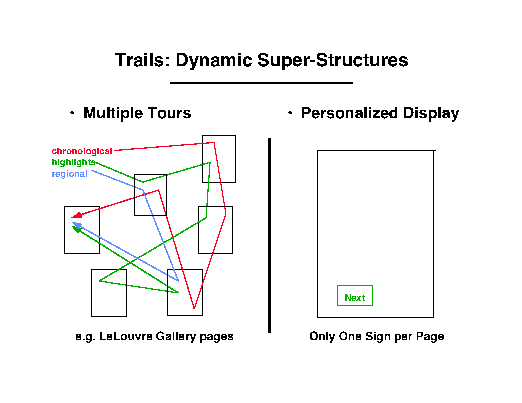
Figure 10
Conclusion
We have developed a generic mechanism for value-added third-party
information, along with corresponding browser extensions for chosing
perspectives, adding annotations, and adminstrating access control.
This mechanism enables a number of usages which add value to the
original information.
We have designed a scalable architecture, that distributes resources
in a way that reflects social, economic, and legal boundary conditions.
The associated protocol allows retrieval of access-controlled
meta-information about documents uniformly and extensibly; it
can be layered on top of existing protocols such as http. A prototype
implementation, using a modified XMosaic browser and server scripts,
has been tested and is being made freely available.
The architecture enables people to make their expertise and comments
available to a selected audience in a structured way. We would
like to see it contribute to a culture of widely distributed commenting
and reviewing, much like the Web has led to a culture of individual
publishing.
- [BUSH]
- Vannevar Bush (1945). Stanford Integrated Digital Library Project.
Computer Science Department, Stanford University. (NSF/ARPA/NASA
proposal). URL: http://www-diglib.stanford.edu/diglib/.
- [COMMENTOR]
- Martin Röscheisen, Christian Mogensen, and Terry Winograd
(1995). ComMentor Documentation.
URL: http://www-diglib.stanford.edu/COMMENTOR/.
- [TR]
- Martin Röscheisen, Christian Mogensen, and Terry Winograd
(1994). A Platform for Third-Party Value-Added Information Providers: Architecture, Protocols, and Usage Examples.
Available at URL http://www-diglib.stanford.edu/COMMENTOR/.
- [TimBL]
- NYTimes (1995). New Internet feature will make voluntary ratings
possible. Proposed self-rating extension from Tim Berners-Lee.
- [Borenstein]
- Borenstein, N. (1995). KidCode. Draft. Available at URL ftp://ftp.fv.com/pub/nsb/draft-kidcode.ps
-
![[DigLib]](logo.diglib.gif)
![[PCD]](logo.pcd.gif)
![[Stanford]](stanford.seal56.gif) -->
-->
Copyright © Martin Röscheisen, Terry Winograd, and
Andreas Paepcke



hdl:cnri.dlib/august95-sidl











![[DigLib]](logo.diglib.gif)
![[PCD]](logo.pcd.gif)
![[Stanford]](stanford.seal56.gif)


